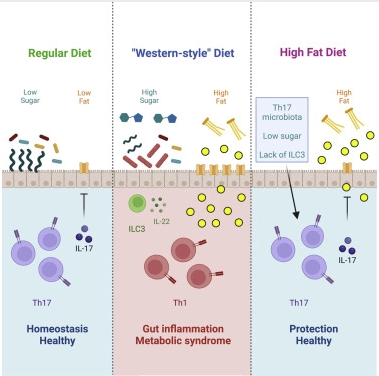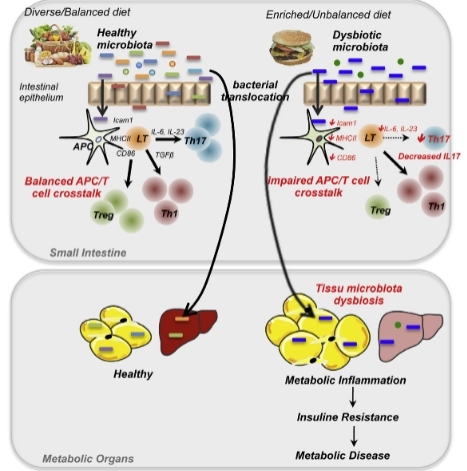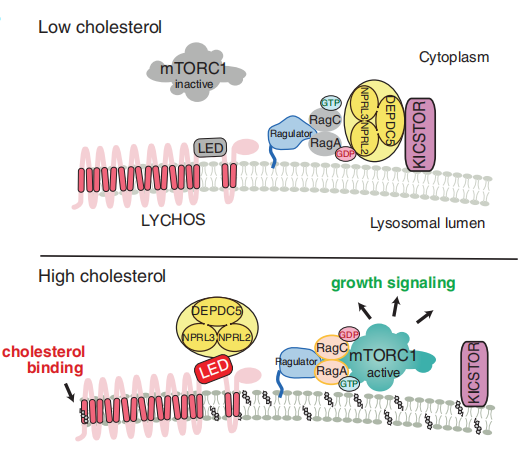博文
代谢学人-Cell&Science&Nature近期代谢精选
|
代谢学人
Cell&Science&Nature近期代谢精选
撰文 | 高铭远 郭文秀 生茂正 于剑
编辑 | 孟美瑶
校对 | 于剑

可爱猫猫带给我们治愈的同时
高兴了还会给我们捣捣乱


吃糖确实甜蜜并能治愈不开心
但甜蜜有时也是要付出代价的
近期Cell发表研究发现
饮食中的糖会通过影响肠道菌群
进而导致肠道Th17细胞数量和功能丧失
增加代谢疾病风险
Cell
1、膳食糖分引起的菌群失衡破坏了免疫介导的代谢综合征保护,并调节炎症和细胞代谢
少吃糖,肠健康
中文摘要
肠道微生物如何调节代谢综合征尚不完全清楚。本研究表明肠道微生物群通过诱导共生Th17细胞来抵抗肥胖、代谢综合征和糖尿病前期发展。高脂、高糖饮食通过消耗微生物诱导的Th17细胞导致代谢疾病发生,补充共生Th17细胞可以恢复其保护作用。微生物诱导的Th17细胞通过IL-17依赖方式调节肠上皮的脂质吸收以提供保护作用。饮食诱导的保护性Th17细胞的丢失则由糖分介导。去除高脂饮食中的糖分能够以共生特异性Th17细胞依赖的方式抵抗小鼠肥胖和代谢综合征。糖和ILC3可以促进小鼠肠道中丹毒丝菌属(Faecalibaculum rodentium)的生长,从而取代了诱导Th17的微生物群。这些结果阐明了引起代谢综合征风险的饮食和微生物群因素。此外,本研究还揭示了膳食糖分免疫致病性的微生物群依赖机制,并强调了饮食、微生物群和肠道免疫之间在调节代谢紊乱方面的复杂相互作用。

拓展阅读
Th17细胞
Th17细胞(T helper 17 cells)由初始CD4+ T细胞分化而来。该细胞群主要聚集在小肠固有层(Small intestine lamina propria, SILP)中,通过分泌高水平的IL-17,保护细胞免受真菌和致病菌的毒害。在人体中,Th17的数量受节段丝状细菌(Segmented filamentous bacteria, SFB)的特异性调节。当小鼠受到HFD等饮食诱导出现代谢综合征特征(如:体重增加、胰岛素抵抗和葡萄糖不耐受)时,由于肠道菌群紊乱,SFB被消耗,引起Th17的含量和功能下调,从而对人体代谢产生负面影响。
有研究证明,Th17细胞分泌的IL-17作为脂肪形成的负调控因子,其在包括脂肪、肝脏和肌肉在内的各种代谢组织中可能直接抑制脂肪细胞的形成和分化,发挥抵抗肥胖的重要作用。但这种抑制作用也会损害脂肪组织的脂质储存,引起胰岛素抵抗。在肥胖患者中,Th17细胞分泌的IL-17水平逐渐降低,使身体无法调节脂肪生成,进一步加重肥胖现象。因此针对Th17细胞的抗炎和免疫调节治疗策略可能有助于改善代谢综合征。

参考文献:
Microbiota imbalance induced by dietary sugar disrupts immune-mediated protection from metabolic syndrome
发表单位:Department of Microbiology and Immunology, Vagelos College of Physicians and Surgeons, Columbia University, New York, USA
How intestinal microbes regulate metabolic syndrome is incompletely understood. We show that intestinal microbiota protects against development of obesity, metabolic syndrome, and pre-diabetic phenotypes by inducing commensal-specific Th17 cells. High-fat, high-sugar diet promoted metabolic disease by depleting Th17-inducing microbes, and recovery of commensal Th17 cells restored protection. Microbiota-induced Th17 cells afforded protection by regulating lipid absorption across intestinal epithelium in an IL-17-dependent manner. Diet-induced loss of protective Th17 cells was mediated by the presence of sugar. Eliminating sugar from high-fat diets protected mice from obesity and metabolic syndrome in a manner dependent on commensal-specific Th17 cells. Sugar and ILC3 promoted outgrowth of Faecalibaculum rodentium that displaced Th17-inducing microbiota. These results define dietary and microbiota factors posing risk for metabolic syndrome. They also define a microbiota-dependent mechanism for immuno-pathogenicity of dietary sugar and highlight an elaborate interaction between diet, microbiota, and intestinal immunity in regulation of metabolic disorders.
智能感应不灵敏
会给生活造成一定困扰


胆固醇是关键的信号分子
其准确感应极为重要
近期Science发表研究发现
细胞内溶酶体定位的蛋白LYCHOS
能够作为细胞内胆固醇的感受器
将信号传递到下游的mTORC1信号通路
Science
2、溶酶体GPCR样蛋白LYCHOS向mTORC1传递胆固醇充足信号
发现一种溶酶体胆固醇信号—LYCHOS
中文摘要
溶酶体通过感知包括胆固醇在内的必需营养素来协调细胞新陈代谢和生长。本研究通过对溶酶体蛋白质组进行生物信息学分析,发现了溶酶体胆固醇信号蛋白(Lysosomal cholesterol signaling, LYCHOS,以前被注释为GPCR155,G蛋白偶联受体155),该蛋白是一种多结构域跨膜蛋白,能够激活胆固醇依赖性的主要生长调节因子—mTORC1 (Mammalian target of rapamycin complex 1, mTORC1)。胆固醇结合到LYCHOS的氨基末端通透酶样区域,突变该位点会损害mTORC1的激活。在高胆固醇浓度下,LYCHOS通过一个保守的面向细胞质的环(cytoplasm-facing loop)与GATOR1复合体结合(GATOR1复合体是一种鸟苷三磷酸酶(GTPase),是RagGTPase的激活蛋白)。通过隔离GATOR1, LYCHOS促进了胆固醇和Rag依赖性mTORC1向溶酶体的募集。因此,LYCHOS在胆固醇感知的溶酶体途径中发挥作用,并将胆固醇浓度与mTORC1依赖的合成代谢信号相结合.
拓展阅读 LYCHOS、溶酶体途径与胆固醇感知 LYCHOS主要通过溶酶体途径感知胆固醇。当胆固醇进入细胞后, LYCHOS蛋白中含有的特殊环结构能够在细胞质基质侧与胆固醇结合,将胆固醇浓度变化信号传递到mTORC1,促进mTORC1向溶酶体募集,进而通过mTORC1信号通路协调细胞的代谢和生长。 有研究表明,当细胞内营养物质匮乏时,具有活性的GATOR1复合物促进RagA/B二聚体蛋白上的GTP水解成GDP,使RagA/B二聚体蛋白以GDP-RagA/B的失活状态存在,无法发挥其激酶与转运载体作用。在RagA/B失活后,受其调控的mTORC1无法通过与RagA/B结合向溶酶体聚集,而是以不活跃状态定位在细胞质中。当LYCHOS感知到细胞内胆固醇充足时,LYCHOS将与GATOR1 结合,从而抑制其发挥水解作用,抑制RagA/B蛋白去磷酸化被抑制,使RagA/B以GTP-RagA/B的活性形式存在。被激活的GTP-RagA/B蛋白可以重新激活 mTORC1活性,使mTORC1向溶酶体募集,从而激活下游mTORC1信号通路。 参考文献: Lysosomal GPCR-like protein LYCHOS signals cholesterol sufficiency to mTORC1 发表单位:Department of Molecular and Cell Biology, University of California at Berkeley, Berkeley, USA Lysosomes coordinate cellular metabolism and growth upon sensing of essential nutrients, including cholesterol. Through bioinformatic analysis of lysosomal proteomes, we identified lysosomal cholesterol signaling (LYCHOS, previously annotated as G protein–coupled receptor 155), a multidomain transmembrane protein that enables cholesterol-dependent activation of the master growth regulator, the protein kinase mechanistic target of rapamycin complex 1 (mTORC1). Cholesterol bound to the amino-terminal permease-like region of LYCHOS, and mutating this site impaired mTORC1 activation. At high cholesterol concentrations, LYCHOS bound to the GATOR1 complex, a guanosine triphosphatase (GTPase)–activating protein for the Rag GTPases, through a conserved cytoplasm-facing loop. By sequestering GATOR1, LYCHOS promotes cholesterol- and Rag-dependent recruitment of mTORC1 to lysosomes. Thus, LYCHOS functions in a lysosomal pathway for cholesterol sensing and couples cholesterol concentrations to mTORC1-dependent anabolic signaling.
猫猫和主人的默契关系
实名羡慕了!

近期Nature发表研究揭示
脂肪与大脑是如何维持默契的
发现脂肪原来也有”感觉“
其通过与源自背根神经节的感觉神经元支配
对脂肪生成和产热进行精密调控
Nature
3、脂肪组织体感神经的支配作用 感觉神经—连接大脑和脂肪的新桥梁
中文摘要
脂肪组织与中枢神经系统之间进行通讯,以维持全身能量稳态。主流观点认为,脂肪分泌的循环激素将代谢状态传递给大脑,大脑整合周围神经信息,并通过去甲肾上腺素能交感神经输出调节脂肪细胞功能。此外,背根神经节的体感神经元支配脂肪组织。然而,由于缺乏基因工具来选择性地靶向这些神经元,这大大限制了对其生理重要性的理解。本研究通过开发病毒、遗传和成像的策略,以特定器官的方式操纵小鼠的感觉神经。能够将背根神经节从躯体到皮下脂肪细胞的整个轴突进行投射,建立了脂肪感觉神经支配的解剖学基础。在功能上,脂肪组织中选择性感觉缺失增强了脂肪生成和生热转录程序,导致脂肪垫增大,米色脂肪细胞富集,且在热中性条件下体温升高。感觉神经缺失诱导的表型需要完整的交感神经功能。由此推测,支配米色脂肪的感觉神经元通过对交感系统起制动作用来调节脂肪细胞的功能。这些结果揭示了脂肪组织背根神经节的神经支配的重要作用,未来也有望用于检测不同内感受系统的感觉神经支配的作用.
拓展阅读 脂肪也有"感觉" 在脂肪组织中,也存在大量神经分布。这些神经介导脂肪组织和中枢神经系统之间的连接和通讯,以保持脂肪健康和全身能量稳态。一般来说,交感神经系统负责调节心脏以及其他内脏器官的活动。但近来有研究发现,脂肪组织的神经元中有近半数没有连接到交感神经系统,而是连接到大脑中感觉神经系统的起始部位—背根神经节处。因此,这些新识别出的神经元属于感觉神经元(也叫传入神经元),其通过将信号传入中枢,引起人体的感觉或反射。 在本研究中,作者发现当脂肪组织感觉神经元受阻时,由交感神经系统调控的白色脂肪棕色化水平升高,产热增强,小鼠体温升高。该研究表明大脑通过感觉神经和交感神经两种完全相反的神经控制脂肪组织协调完成机体相关的代谢过程。其中,交感神经元增强脂肪产热和脂代谢水平,感觉神经元则降低脂肪产热和脂代谢水平,这些结果揭示了脂肪组织背根神经节神经支配的重要作用。 参考文献: The role of somatosensory innervation of adipose tissues 发表单位:Department of Neuroscience, Dorris Neuroscience Center, Scripps Research, San Diego, CA, USA. Adipose tissues communicate with the central nervous system to maintain whole-body energy homeostasis. The mainstream view is that circulating hormones secreted by the fat convey the metabolic state to the brain, which integrates peripheral information and regulates adipocyte function through noradrenergic sympathetic output. Moreover, somatosensory neurons of the dorsal root ganglia innervate adipose tissue. However, the lack of genetic tools to selectively target these neurons has limited understanding of their physiological importance. Here we developed viral, genetic and imaging strategies to manipulate sensory nerves in an organ-specific manner in mice. This enabled us to visualize the entire axonal projection of dorsal root ganglia from the soma to subcutaneous adipocytes, establishing the anatomical underpinnings of adipose sensory innervation. Functionally, selective sensory ablation in adipose tissue enhanced the lipogenic and thermogenetic transcriptional programs, resulting in an enlarged fat pad, enrichment of beige adipocytes and elevated body temperature under thermoneutral conditions. The sensory-ablation-induced phenotypes required intact sympathetic function. We postulate that beige-fat-innervating sensory neurons modulate adipocyte function by acting as a brake on the sympathetic system. These results reveal an important role of the innervation by dorsal root ganglia of adipose tissues, and could enable future studies to examine the role of sensory innervation of disparate interoceptive systems.
关注微信公众号代谢学人
了解更多代谢前沿资讯

https://blog.sciencenet.cn/blog-3483272-1361188.html
上一篇:代谢学人--Nature:U,执行A计划!线粒体UCP1/AAC机制大揭秘
下一篇:代谢学人——Nature Metabolism:内质网应激促肥胖?原来是IRE1α在捣乱!